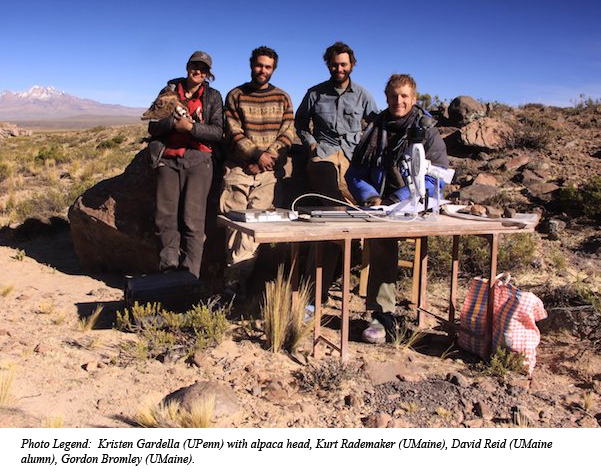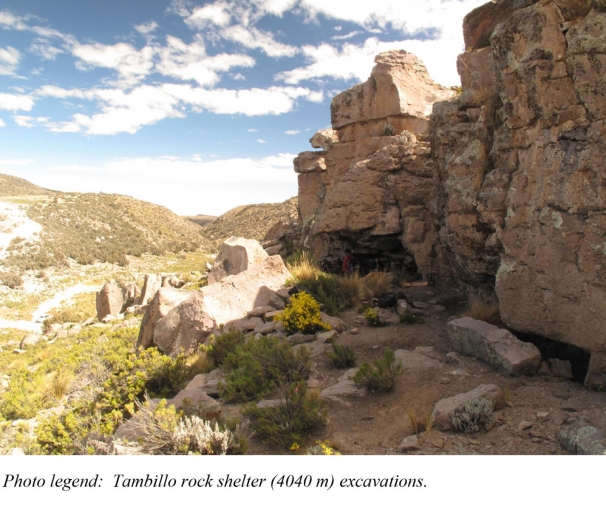
Glacial Geology and Archaeology in the Pucuncho Basin, Peruvian Andes
Pucuncho Basin, Peruvian Andes
Glacial Geology and Archaeology in the Pucuncho Basin, Peruvian Andes
Kurt Rademaker and Gordon Bromley, Kristen Gardella (UPenn), Peter Leach and David Reid (J. A. Milner & Associates), Jesse Wertheim and Owen McGlamery (UMaine undergraduates).
June 1-August 23, 2010
Project Summary
The timing and process of the initial settlement of high mountain zones remains a controversial, unresolved issue. One currently accepted hypothesis proposes that high-altitude late-glacial environments presented extreme physiological, behavioral, and demographic challenges for colonizing foragers. This “high-altitude biogeographic barrier” model is based on the absence of unequivocal pre-Holocene archaeological evidence >3500 m in the Andesand pre-8200 calibrated years before present (cal B.P.) evidence on the high Tibetan Plateau. Colder temperatures, greater glacial extents, lack of biotic habitats, and hypoxia (low-oxygen conditions) all are assumed to have presented insurmountable barriers to foragers. However, few high-altitude areas have been studied archaeologically, begging the question of whether adequate data exists to substantiate the current model.
Churchill Exploration funding has been vital in the success of our interdisciplinary investigations, enabling us to work jointly on our Ph.D. dissertation projects in the high Andes of southern Peru since 2005. As part of these investigations, we have produced accurate records of local glacier and climate fluctuations since the last glacial maximum (LGM, ~20,000 cal B.P.)at Nevado Coropuna, a glaciated volcano on the southern edge of the Pucuncho Basin (Nevado Coropuna Expeditions, 2006-07). We have mapped and characterized Alca obsidian deposits in the highlands east of the Cotahuasi Canyon (Cotahuasi Valley and Plateau Expedition, 2008), and we have pinpointed a small Alca-1 deposit at Pucuncho as the probable source for obsidian artifacts at the late-glacial-age (~10,600-13,000 cal B.P.) coastal site Quebrada Jaguay (Pucuncho Basin Expeditions, 2008-09). Using predictive computer models, we have searched for archaeological sites along likely routes from the coast to the highlands (Quebrada Manga Expedition, 2007).
Through these efforts we have discovered projectile points dating from the late-glacial and Early Holocene periods, and ten rock shelters and two open-air sites likely to contain evidence of Paleoindian occupation at the Pucuncho basin and nearby drainages. These sites are the focus of this year’s field investigations.
Exactly when did people arrive to Earth’s high-altitude mountains? What were late-glacial Andean high-mountain environments like? Were biotic habitats available? Answering these questions and understanding their implications for the adaptive capacity of humans requires comparable and high-resolution paleoenvironmental and archaeological chronologies. The Pucuncho area contains one of the largest wetlands in the west-central Andes, well-preserved glacial landforms and sedimentary exposures, and the world’s highest evidence of late ice age Paleoindian occupation, making it ideal for developing these comparative chronologies.
The principal objective of our research is to provide robust late-glacial archaeological and paleoecologic chronologies at Pucuncho. Comparison of these records will address the research questions: (i) did human colonization occur before, during, or after formation of wetlands in the Pucuncho basin and surrounding valleys?, and (ii) did significant lags occur between deglaciation, wetland development, and human use of this area?
This year we continued glacial geologic study of landforms surrounding Nevado Coropuna, conducted ground-penetrating radar of rock shelters and systematic surface collection and mapping of open-air sites, and test-excavated four rock shelter sites. Analyses of materials recovered from the sites are underway, which will reveal information on the early human settlement of the high-altitude Andes. A geologic section we sampled extensively will provide important long-term paleoecologic data to help us better understand the development of high-altitude Central Andean ecosystems and interactions between early human explorers and their environments.



